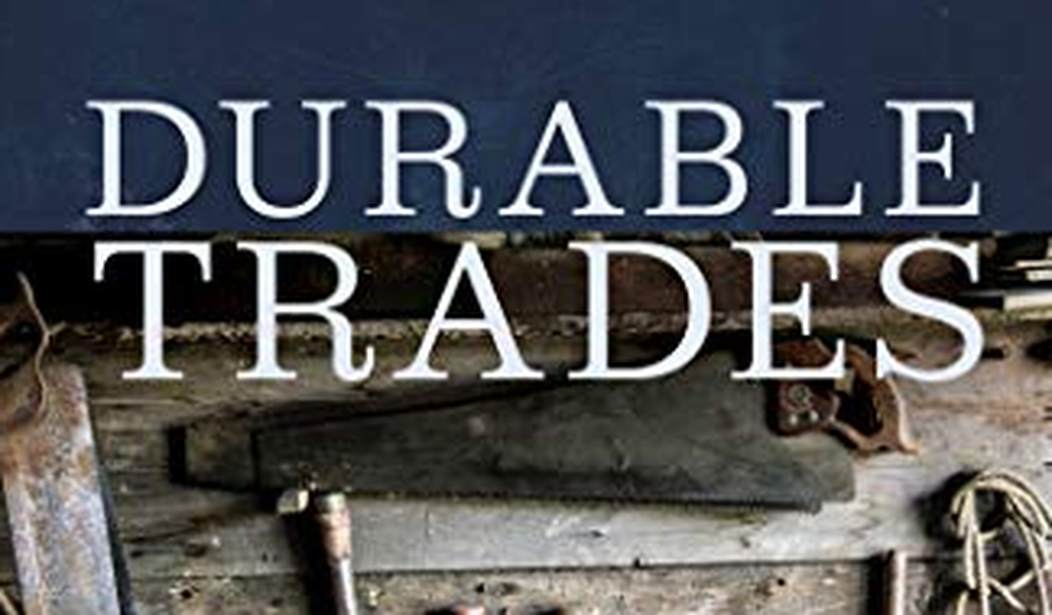Is your career durable? Has it stood the test of time or will you be replaced by a robot in a few years? Rory Groves, in Durable Trades: Family-Centered Economies that Have Stood the Test of Time, pulls back the veil on what makes a profession durable and why.
Durable Trades is more than a career guide; it’s a treatise on why certain professions have always been necessary and what makes a career fulfilling. It is also an argument for a return to family-centered economies rather than a focus on climbing the career ladder. In the foreword to the book, Dr. Allan C. Carlson explains, “While almost every other ‘career book’ buys into the argument that workers will need to completely retrain every five to seven years just to keep a job, this author proves that there are many rich and rewarding forms of labor with astonishing records of durability.”
Groves, a computer scientist turned homesteader, changed professions mid-career out of a desire to spend more of his time “building things that will last.” As a former computer scientist, the author admits that he has seen his share of “obsolescence.”
“Nothing can be more temporary than what comes out of Silicon Valley,” he adds. “We live in a time when companies employ ‘planned obsolescence’ to make sure things they produce wear out and need to be replaced, so we need to keep earning money to buy the replacements.”
In contrast, during previous generations, things that broke down were fixed or repurposed. Neither were people disposable. “A person’s worth was not the net total of his paycheck. Children were viewed as gifts from God and the elderly revered as the wellspring of wisdom. Everyone from cradle to grave had value and purpose and was needed by the community if the community were to survive.”
With the arrival of the Industrial Revolution, “efficiency became our highest virtue,” posits Groves, “and with it, generational stability collapsed.” The factory “replaced the family as the primary means of sustenance” and opportunities for “apprenticeship, relationship, and cross-generational continuity of values and culture disappeared.”
Family-centered trades, Groves argues, “are not only the most durable throughout history; they are also the ideal context by which parents can pass their values, faith, and culture on to the next generation.”
In the book’s first chapter Groves explains that “as societies face problems, they increase in complexity in order to solve them.” And, indeed, the number of occupations over the last two centuries has exploded. “At the founding of our country, there were at most a few dozen distinct occupations,” he says. “Within 100 years that number had risen to over 8,000. Today there are over 30,000 occupations, with dozens of new specialties being invented daily.”
The book goes on to compare and contrast U.S. employment in 1900 and 2010. In the former, agriculture, mining, fishing, and forestry were at the bottom of a pyramid; secondary professions (manufacturing, processes, construction) were in the middle; tertiary, or service, jobs (sales, health care, banking, law) were above that; at the top, occupying a tiny space, is what Groves calls the quaternary, or knowledge, professions (research, education, engineering).
The pyramid representing 2010 is inverted, with knowledge professions at the top; primary professions occupied the smallest portion of U.S. employment in 2010.
“Within a relatively short timeframe, Western nations have come to rely on a minuscule proportion of their fellow citizens to supply the vast majority of their needs,” says Groves.
“It was not that long ago that every American citizen, regardless of occupation, possessed the skills to provide his or her own food, shelter, and clothing, should the need ever arise,” Groves laments. While he acknowledges that, in regards to material abundance, Americans are “vastly richer than our forebears,” “in terms of relationships to each other, to the land, and to God, our forbears were much richer than we.”
“If quality of life consists merely of the abundance of possessions, if our value to society is based solely on our productive capacity, if money, things, careers and people are perpetually becoming obsolete, what have we profited by gaining the whole world?” Groves asks, paraphrasing the words of Jesus in Mark 8:36.
Groves goes on to detail problems with the darker side of technology: the shrinking American family, the decline of Christianity in America, and the rise of neopaganism.
In defining what he considers a “durable” trade, Groves draws on lessons from the past.
Defining “durable” has not been easy. I wanted to know which types of businesses have been the least affected by external factors throughout history, place, governments, economic cycles, invention, and social upheaval. Which trades have endured for centuries and still exist today? Which trades are the most family-centric? And, of course, which trades do all this and still provide a living? Conversely, which trades are overly dependent on brittle systems and therefore not likely to withstand economic, societal and technological upheaval?
After “examining hundreds of occupations spanning the past four centuries,” Groves developed a five-part scoring system to evaluate the merits of each. Each trade on his list has survived for at least 230 years, “and in most cases several thousand years.” The ranking was based on:
- Historical stability (20%)
- Resiliency (15%)
- Family-centeredness (35%)
- Income (20%)
- Ease of entry (10%)
For example, the job of shepherding (ranching, livestock farming, dairy working), which came in at number one on the list, received 88% for historical stability; 93% for resiliency; 100% for family-centeredness; 80% for income; and 74% for ease of entry to the profession. By contrast, the lawyering profession, ranked at number 20, received scores of 76% for historical stability; 83% for resiliency; 41% for family-centeredness; 100% for income; and 44% for ease of entry.
Part II of the book includes some key findings of his research as well as a list of the 20 most durable professions. It should be noted that the professions are described using their original descriptors rather than their current titles. Each profession listed includes a description of the work and the rationale for the scores in each section, along with data from the U.S. Bureau of Labor Statistics. Each section also helpfully includes a profile of an individual or business thriving in that profession. An appendix at the conclusion of the book provides the ranking in table form.
The top 10 durable professions, according to Groves, are:
- Shepherd (rancher, livestock farmer, dairyman)
- Farmer
- Midwife
- Gardener (arborist, vinedresser, landscaper, flower farmer)
- Woodworker (cabinetmaker, finish carpenter)
- Carpenter (a builder of structures)
- Painter (siding contractor, wall covering specialist)
- Cook (chef, caterer, restauranteur)
- Brewer (winemaker, distiller)
- Innkeeper (hotelier)
Groves follows up the top 20 list with dozens of professions that received “honorable mentions.” The author cautions that his research focused on historical data rather than projecting which professions might be important in the future. Still, the longevity of professions that made the list are certain to give the readers pause before writing off trades in favor of more modern professions.
This book will be of immense interest to students and parents who are in the process of determining career and educational paths. It may also be useful to mid-career professionals who either fear future obsolescence or find themselves unfulfilled by their current career path.
“If there is anything that can withstand the nihilistic effects of modernity and the uncertain outcomes of our high towers, it will be families that are reclaiming critical functions at home—education, apprenticeship, discipleship—and working together towards a common vision to which they have been called,” Groves declares in the conclusion, noting that the family economy “has been the context by which parents pass their faith, culture and values on to their children for most of human history.”










Join the conversation as a VIP Member